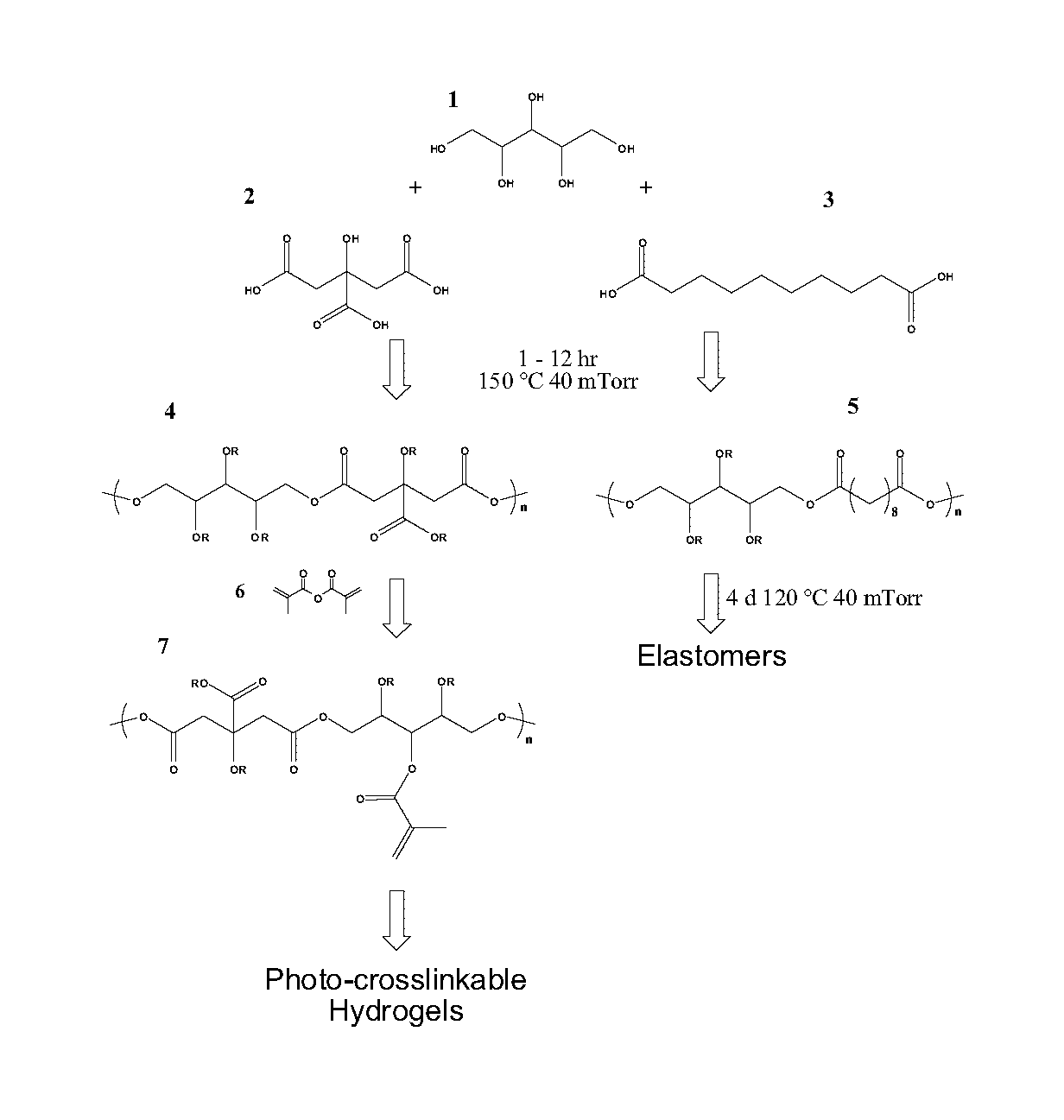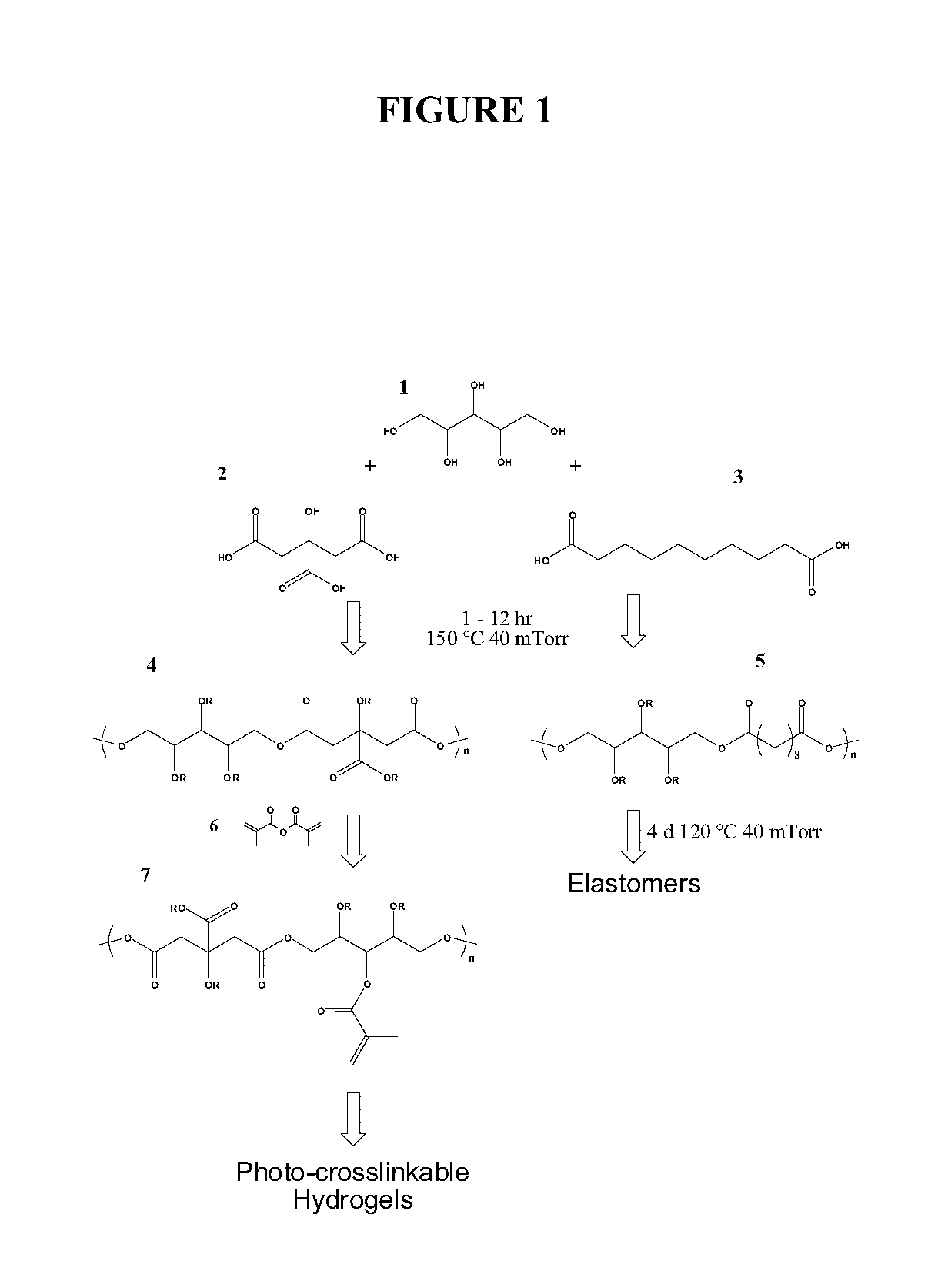Polyol-based polymers
a polymer and polymer technology, applied in the field of polymer-based polymers, can solve problems such as the challenge of designing biomaterials, and achieve the effect of being easy to prepar
- Summary
- Abstract
- Description
- Claims
- Application Information
AI Technical Summary
Benefits of technology
Problems solved by technology
Method used
Image
Examples
example 1
Xylitol Based Polymers
Biodegradable Waxy Polymers, Hydrogels, and Elastomers
[0362]The first step in the synthesis of all pre-polymers includes a polycondensation reaction. Xylitol and the polycarboxylic acid are melted under an inert atmosphere at a temperature of approximately 100-120° C. Then the polycondensation reaction is initiated after 6 hours, continuously stirring in vacuo. These thermoplastic pre-polymers can be divided based on their solubility in water. Water soluble prepolymers can be used as waxy polymer, or further processed into photocrosslinkable and / or in situ crosslinkable hydrogels. The water insoluble pre-polymers can be used as a thermoplastic, waxy polymer, or further processed into elastomers, either through polycondensation, photopolymerization, and / or in situ polymerization.
[0363]Experiment 1a: The water soluble pre-polymers are synthesized using xylitol and glutaric acid with a 1:1 molar ratio. The polycondensation was done at 100° C., for 5 hours in vacuo...
example 2
Biodegradable Xylitol-Based Polymers
[0382]In this Example, we describe xylitol-based polymers. Polycondensation of xylitol with water soluble citric acid yielded biodegradable, water soluble polymers. Acrylation of this polymer resulted in an elastomeric photocrosslinkable hydrogel. Polycondensation of xylitol with the water insoluble sebacic acid monomer produced tough biodegradable elastomers, with tunable mechanical and degradation properties. These xylitol-based polymers exhibited excellent in vitro and in vivo biocompatibility compared to the well-characterized poly(L-lactic-co-glycolic acid) (PLGA), and are promising biomaterials.
[0383]Sebacic acid (a metabolite in the oxidation of fatty acids) and citric acid (a metabolite in the Krebs cycle) were chosen as the reacting monomers for their proven biocompatibility (Y. Wang, G. A. Ameer, B. J. Sheppard, R. Langer, A tough biodegradable elastomer. Nat Biotechnol 2002, 20, (6), 602-606; J. Yang, A. R. Webb, G. A. Ameer, Novel Citr...
example 3
Biodegradable Poly(polyol sebacate) Polymers
[0393]In this Example, polyols were reacted with sebacic acid, yielding a family of thermoset poly(polyol sebacate) (PPS) polymers. Monomers of PPS polymers have the potential to be metabolized in vivo since sebacic acid is a metabolite in fatty acid oxidation and polyols are intermediates in mammalian carbohydrate metabolism. Polyols such as xylitol, sorbitol, mannitol, and maltitol are biocompatible, FDA approved, and are metabolized in an insulin-independent manner (K. C. Elwood, Methods available to estimate the energy values of sugar alcohols. Am J Clin Nutr 1995, 62 (Suppl), 1169-1174; S. S, Natah, K. R. Hussien, J. A. Tuominen, V. A. Koivisto, Metabolic response to lactitol and xylitol in healthy men. Am J Clin Nutr 1997, 65, (4), 947-950; L. Sestoft, An evaluation of biochemical aspects of intravenous fructose, sorbitol and xylitol administration in man. Acta Anaesthesiol Scand Suppl 1985, 82, 19-29; each of which is incorporated h...
PUM
| Property | Measurement | Unit |
|---|---|---|
| in-vivo half life | aaaaa | aaaaa |
| in-vivo | aaaaa | aaaaa |
| in-vivo | aaaaa | aaaaa |
Abstract
Description
Claims
Application Information
 Login to View More
Login to View More - R&D
- Intellectual Property
- Life Sciences
- Materials
- Tech Scout
- Unparalleled Data Quality
- Higher Quality Content
- 60% Fewer Hallucinations
Browse by: Latest US Patents, China's latest patents, Technical Efficacy Thesaurus, Application Domain, Technology Topic, Popular Technical Reports.
© 2025 PatSnap. All rights reserved.Legal|Privacy policy|Modern Slavery Act Transparency Statement|Sitemap|About US| Contact US: help@patsnap.com



